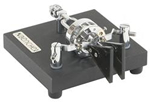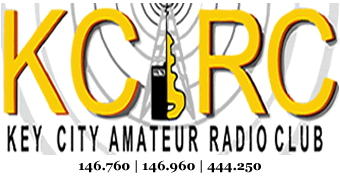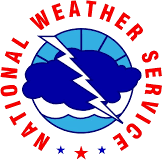Although CW (Morse code) is no longer a requirement in order to obtain an amateur radio (Ham) license; many operators still enjoy this part of the hobby.
Note: CW stands for ‘continuous wave’.
Did you know?

Morse code is a character encoding scheme used in telecommunication that encodes text characters as standardized sequences of two different signal durations called dots and dashes or dits and dahs. Morse code is named for Samuel F. B. Morse, an inventor of the telegraph.
Note: SOS is the International Morse code distress signal.

Amateur radio

Vibroplex brand semiautomatic key (generically called a “bug”). The paddle, when pressed to the right by the thumb, generates a series of dits, the length and timing of which are controlled by a sliding weight toward the rear of the unit. When pressed to the left by the knuckle of the index finger, the paddle generates a single dah, the length of which is controlled by the operator. Multiple dahs require multiple presses. Left-handed operators use a key built as a mirror image of this one.
International Morse code today is most popular among amateur radio operators, in the mode commonly referred to as “continuous wave” or “CW”. (This name was chosen to distinguish it from the damped wave emissions from spark transmitters, not because the transmission is continuous.) Other keying methods are available in radio telegraphy, such as frequency shift keying.
The original amateur radio operators used Morse code exclusively since voice-capable radio transmitters did not become commonly available until around 1920. Until 2003, the International Telecommunication Union mandated Morse code proficiency as part of the amateur radio licensing procedure worldwide. However, the World Radiocommunication Conference (WRC) of 2003 made the Morse code requirement for amateur radio licensing optional. Many countries subsequently removed the Morse code requirement from their license requirements.
Until 1991, a demonstration of the ability to send and receive Morse code at a minimum of five words per minute (wpm) was required to receive an amateur radio license for use in the United States from the Federal Communications Commission. Demonstration of this ability was still required for the privilege to use the HF bands. Until 2000, proficiency at the 20-wpm level was required to receive the highest level of amateur license (Amateur Extra Class); effective April 15, 2000, the FCC reduced the Extra Class requirement to five wpm.
Finally, effective on February 23, 2007, the FCC eliminated the Morse code proficiency requirements from all amateur radio licenses.
While voice and data transmissions are limited to specific amateur radio bands under U.S. rules, Morse code is permitted on all amateur bands – LF, MF, HF, VHF, and UHF. In some countries, certain portions of the amateur radio bands are reserved for transmission of Morse code signals only.
The relatively limited speed at which Morse code can be sent led to the development of an extensive number of abbreviations to speed communication. These include prosigns, Q codes, and a set of Morse code abbreviations for typical message components. For example, CQ is broadcast to be interpreted as “seek you” (I’d like to converse with anyone who can hear my signal). OM (old man), YL (young lady) and XYL (“ex-YL” – wife) are common abbreviations. YL or OM is used by an operator when referring to the other operator, XYL or OM is used by an operator when referring to his or her spouse. QTH is “location” (“My QTH” is “My location”). The use of abbreviations for common terms permits conversation even when the operators speak different languages.

Although the traditional telegraph key (straight key) is still used by some amateurs, the use of mechanical semi-automatic keyers (known as “bugs”) and of fully automatic electronic keyers is prevalent today. Software is also frequently employed to produce and decode Morse code radio signals.
Many amateur radio repeaters identify with Morse code, even though they are used for voice communications.
<Wikipedia>



 KCARC meets the 2nd Monday of the month [except December] at 7:00 pm.
KCARC meets the 2nd Monday of the month [except December] at 7:00 pm.